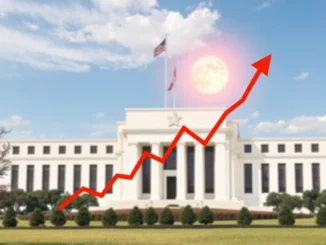
While cryptocurrency markets often march to their own beat, they don’t exist in a vacuum. Events in traditional finance and global economics can create ripple effects, influencing investor sentiment and market volatility. That’s why news impacting major markets, like the recent movement in US stock futures, warrants attention.
What Triggered the Sharp Drop in US Stock Futures?
Recently, US stock futures experienced a notable decline. This downward movement was primarily attributed to comments made by former U.S. President Donald Trump. According to a report shared by Walter Bloomberg on X, Trump proposed a significant 50% tariff on goods imported from the European Union.
The proposal specifically targets products built or manufactured within the EU, suggesting a potential implementation date of June 1. He also noted that products manufactured or built in the U.S. would be exempt from this proposed tax.
Understanding the Proposed Trump Tariffs on EU Imports
The idea of implementing Trump tariffs is not new, but the scale and specific target of this latest proposal caught market participants off guard. A 50% tariff on EU imports represents a substantial barrier to trade between the United States and the European Union, two of the world’s largest economic blocs.
Here are key details from the report:
- Proposed Tariff Rate: 50%
- Target: Products built or manufactured in the European Union
- Proposed Start Date: June 1
- Exemption: Products built or manufactured in the U.S.
How Did the Market React to the Tariff News?
The immediate market reaction was negative. Following the news breaking, US stock futures extended their losses. Futures contracts are essentially bets on where traders believe stock indices like the S&P 500, Nasdaq, and Dow Jones will open later in the trading day. A drop in futures indicates expectations of a lower open for the broader market.
This reaction highlights how sensitive global markets are to potential trade disputes and protectionist policies. Tariffs can disrupt supply chains, increase costs for businesses and consumers, and reduce international trade volumes, all of which can weigh on corporate earnings and economic growth prospects.
Why Does This Create Economic Uncertainty (And Why It Matters for Crypto)?
Proposals like a 50% tariff on EU imports inject significant economic uncertainty into the global landscape. Businesses that rely on imports or exports between the US and EU face potential disruption and increased costs, making future planning difficult. This uncertainty can lead to reduced investment and slower economic activity.
For the cryptocurrency market, increased economic uncertainty in traditional finance can have varied effects. Sometimes, investors may seek safer assets, potentially including stablecoins or even Bitcoin if viewed as a hedge against traditional system instability. At other times, a general flight from risk assets can occur, impacting crypto negatively alongside stocks. This news serves as a reminder that macro events are crucial drivers of overall market sentiment, including within the crypto space.
What’s Next?
While this was a reported proposal and not yet official policy, the market’s swift negative market reaction underscores the potential impact. Traders and investors will be closely watching for any further developments regarding the proposed Trump tariffs and how they might influence global trade relations and, by extension, the broader financial markets that interact with the crypto ecosystem.
Summary
News of a potential 50% tariff on EU imports, reportedly proposed by Donald Trump, caused US stock futures to fall. This event highlights the interconnectedness of global markets and the potential for political actions to create significant economic uncertainty. For those in the crypto space, understanding these traditional finance tremors is key to navigating the broader market reaction landscape.



